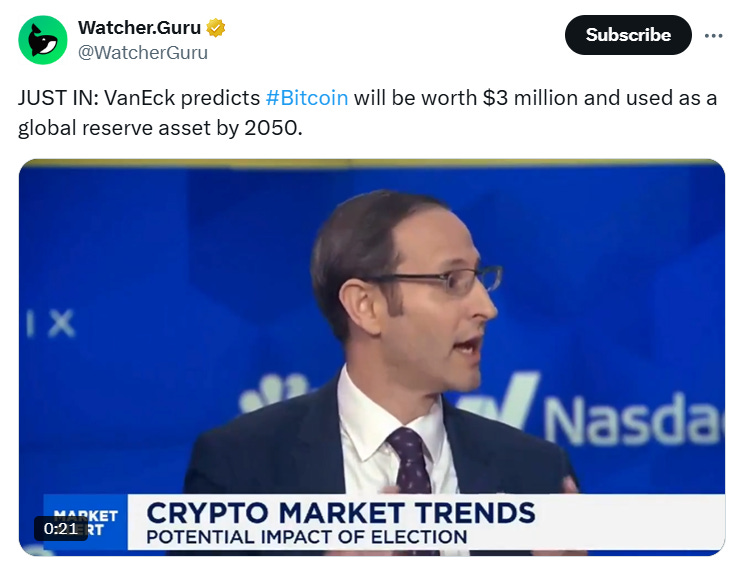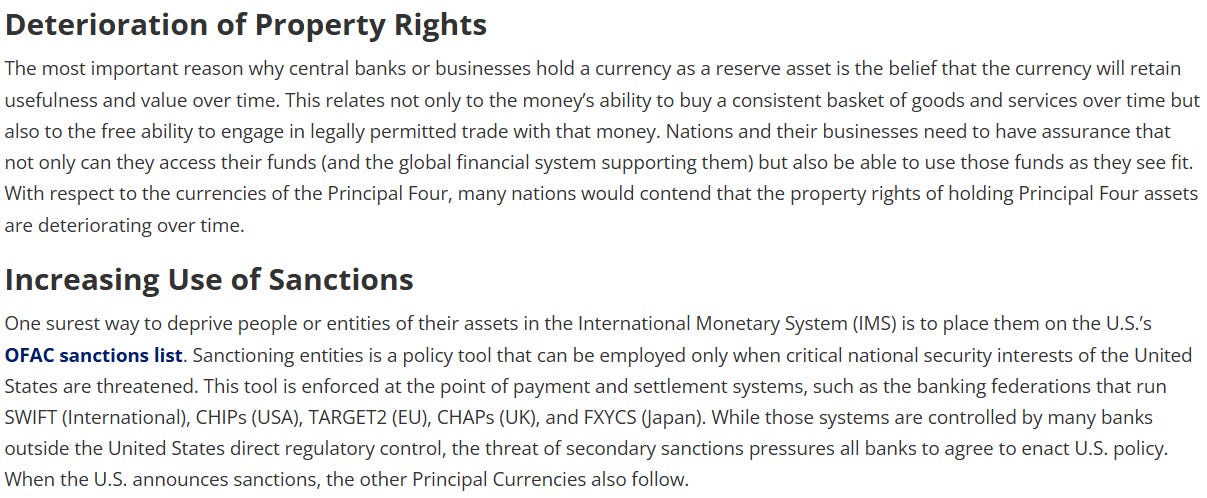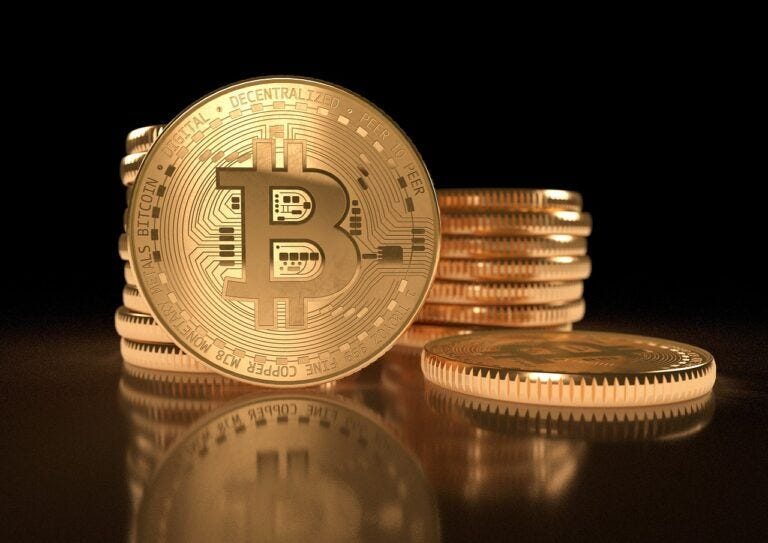Welcome to The Wolf Den! This is where I share the news, my ideas about the market, technical analysis, education and my random musings. The newsletter is released every weekday and is completely FREE. Subscribe!
Today’s Newsletter Is Made Possible By Phemex!
Phemex is the most efficient crypto trading and investment platform. Phemex offers over 293 spot trading pairs, minimal fees, peer-to-peer trading, derivatives, up to 100x leverage, and $8,800 welcome rewards up for grabs! Also for a limited time, if you mint your soul pass you will pay no gas fees and enjoy VIP benefits. Use MY LINK to get the rewards!
Make sure to check if Phemex is available in your jurisdiction.
In This Issue:
Bitcoin For President
Bitcoin Thoughts And Analysis
Altcoin Charts
Legacy Markets
Microsoft Is Voting On Bitcoin
MicroStrategy Is A Beast
Emory University Is Making History
Coinbase Will Sponsor The Warriors
Bitcoin Set To Skyrocket To $80K After Election? | Macro Monday
Bitcoin For President
The U.S. election is exactly one week away, and it’s shaping up to be perhaps the most pivotal moment for crypto yet. With a pro-crypto president who follows through, we could see a revolutionized SEC, widespread approval of crypto ETFs, a potential Bitcoin reserve, a commitment not to sell U.S. held Bitcoin, the dropping of key lawsuits/investigations, clear legislative guidelines, the return of offshore companies, a halt to CBDC initiatives, and an end to Operation Choke Point 2.0.
All of this is it at stake and more.
Either way it goes, Bitcoin will remain resilient regardless; however, another four years under an American anti-crypto administration would make for a long, challenging road for everything else in the crypto space. Even Ethereum, despite having an ETF, hasn’t received a definitive regulatory green light. And Solana, well, it is performing great, but it still faces multiple lawsuits labeling it a security. Not exactly ideal if the current administration decides to take its crusade one step further. Let’s hope they pivot if they win.
Anyway, I know I'll be talking about the election ad nauseam in the coming days and weeks, so I’d like to shift focus to something that happened yesterday that needs a full re-exploration.
Without further ado, let’s begin.
Yesterday, a VanEck video featuring Matthew Siegel, Head of Digital Asset Research, went viral as he shared the firm’s long-term outlook for Bitcoin, looking decades into the future. I’ve transcribed his comments below and revisited the “Bitcoin 2050 Valuation Scenarios: Global Medium of Exchange and Reserve Asset” thesis, which I’ve also analyzed in detail. The report is extensive but absolutely worth the read. For those who prefer highlights, I’ve included them all below.
“We have a model that assumes that, by 2050—this is very long-term—Bitcoin becomes a reserve asset that’s used in global trade and held by global central banks at a very modest 2% weight. In that model, we arrive at a $3 million price target for Bitcoin. Now, that sounds extreme, but that's a 16% compound annual growth rate over a couple of decades, which is really not that extreme for Bitcoin. Into the millions over the medium term is a high-conviction call.”
“Introduction: By 2050, we see bitcoin (BTC) solidifying its position as a key international medium of exchange, ultimately becoming one of the world’s reserve currencies. This projection is rooted in the anticipated erosion of trust in current reserve assets. Crucially, we believe that Bitcoin’s scalability issues which have been the primary barrier to its widespread adoption, will be resolved by emerging Bitcoin Layer-2 (L2) solutions. The combination of Bitcoin’s immutable property rights and sound money principles with the enhanced functionality provided by L2 solutions could enable the creation of a global financial system capable of better meeting the developing world's needs.”
I have to admit, it’s refreshing to think about Bitcoin on this long-term horizon rather than focusing on the upcoming U.S. election. If Bitcoin truly is the generational asset we all believe it to be, then by 2050—or even by 2032 (three elections from now, soon to be two)—we’ll almost certainly have forgotten the impact Kamala or Trump had on this industry, for better or worse.
In essence, VanEck argues that as confidence in traditional reserve currencies wanes due to unchecked deficit spending and geopolitical challenges, Bitcoin stands out as a credible alternative. They predict that businesses and consumers will increasingly turn to Bitcoin as a neutral medium of exchange, valued for its secure property rights and stable monetary policy.
Take a look at this image. It looks confusing, but I’ll explain.
The image outlines the expected economic decline of the Principal Four nations (the U.S., EU, UK, and Japan) by 2050, driven by shrinking populations and low economic growth. As their share of global GDP decreases, these countries may face a rising debt-to-GDP ratio, meaning they will be burdened by more debt relative to their economic output. Using IMF estimates and demographic projections, the authors forecast a challenging fiscal environment for these nations, influenced by factors such as inflation, deficit spending, and debt maturity—hence a need for Bitcoin.
Things are about to get really interesting from here. The image above also illustrates how periodic crises can significantly impact debt levels. In the “Base” scenario, projections indicate that federal government debt payments as a percentage of GDP for the major reserve currency nations will surpass 5% annually, with Japan and the U.S. potentially reaching as high as 10% and 8%, respectively. Importantly, these forecasts do not factor in major crises like the 2001 terrorist attacks, the 2008 financial crisis, or the 2020 pandemic, all of which previously resulted in substantial increases in debt.
Here are two additional points from VanEck that are often overlooked in everyday discussions about Bitcoin. Bitcoin is 21st century financial property and alternative option when individuals’ currencies are sanctioned.
“In summary, institutional momentum within the United States to abrogate property rights is increasing. At the same time, fiscal reasons for seizing property are materializing. How will U.S. dollar (and proxy currencies) holders respond to a climate of arbitrary seizure supported by legal precedence? Increasingly, nations have stopped only making loud noises about injustices, real and potential; they have begun to walk away from the current stalwarts of the International Monetary System.”
Here's another valuable excerpt from the report. Notably, VanEck released this analysis prior to the announcement regarding the potential adoption of a Bitcoin strategic reserve by the U.S.
According to the report, “Bitcoin offers its holders:
Trustlessness: Bitcoin eliminates the need for intermediaries, allowing users to transact directly without relying on third-party trust, enhancing security and autonomy.
Neutrality: Bitcoin operates as a politically and economically agnostic system, free from the influence of biased authorities or agendas, making it accessible to all.
Immutable monetary policy: With a fixed monetary policy determined by its users, Bitcoin ensures that its value cannot be arbitrarily diluted by central banks, maintaining stability and trust.
Perfect property rights: Bitcoin grants holders absolute ownership, as only those with access to private keys can control their assets, preventing arbitrary seizure and enhancing security.
From this point, VanEck spends time detailing where gold lacks in comparison to Bitcoin, bolstering the argument for why Bitcoin will become a reserve currency.
The physical nature of gold makes it cumbersome and expensive to transport and store securely, complicating large-scale transactions despite electronic recording systems.
Gold lacks the flexibility for modern financial systems, as it cannot be easily divided for everyday transactions or effectively used in complex financial instruments.
Holding and transporting gold involves significant security risks, including theft and loss, which increase costs and complexity in international transactions.
Gold does not integrate well into modern financial systems that require rapid and flexible transactions, as electronic fiat transactions are much faster and more efficient.
Following the section on gold, VanEck delves into Bitcoin layer-2 solutions, BTC-backed tokens, lightning networks, sidechains, and rollups. While these topics are significant, they can be quite technical and somewhat tedious for our discussion here. By skipping this part, we can move on to the grand finale, everyone’s favorite part, VanEck’s, “Bitcoin Valuation by 2050.”
According to VanEck, by 2050, Bitcoin is expected to become a crucial part of the International Monetary System, capturing market share from the Principal Four currencies as it gains traction in international trade and serves as a significant medium of exchange and store of wealth. This could create a feedback loop where increasing demand from central banks and investors reduces Bitcoin’s available supply. Projections suggest Bitcoin will account for 10% of cross-border payments and 5% of domestic trade, with 2.5% of central bank assets held in BTC and around 85% effectively removed from circulation. With an anticipated value of $2.9 million per Bitcoin, this would represent about 1.66% of all global financial assets, up from 0.1% today.
Of course, many of these numbers are tough to predict due to various factors, including ‘unpredictable crises’ that lead to massive spending, which is why VanEck simplifies their projections into “bear,” “base,” and “bull” scenarios.
Here is the first half of VanEck’s chart. You'll notice that some variables, like the “International Trade Growth Rate (%)” and “Global GDP Growth Rate (%)” have been kept constant as basic assumptions.
The bolded numbers are what everyone wants to see: VanEck’s “Base Scenario” projects Bitcoin at $2.9 million, the “Bear Scenario” at $130,314, and the “Bull Scenario” at $52.3 million.
$52.3 million per Bitcoin in the bull case is a massive number, but keep in mind that the base case of $2.9 million is only about 5.5% of that bull case. This can stir up some pretty euphoric feelings, which is why VanEck wisely wraps up the report with everyone's next favorite section: “Bitcoin Investment Risks.”
There are 11 points in total, of which I created a one sentence summary for each.
Sustainability of Bitcoin Mining: Future Bitcoin mining could see a hash rate rise to 13.1B TH/s and total power consumption hitting 9.181M GW/h, highlighting the urgent need for innovations in chip design and energy production for sustainability.
Failed economics of miners: Bitcoin relies on a consistent influx of buying to offset miners' selling, especially as inflation decreases.
Failure to scale: Without adequate scaling, Bitcoin's potential as a medium of exchange will be undermined.
Competition from other cryptocurrencies: Numerous ecosystems are vying for Bitcoin's market share, with some, like Ethereum, actively promoting their tokens as money.
Community schism: The divided BTC community on sustaining mining costs could lead to schisms and hard forks, splitting BTC’s value across networks.
Disastrous changes to Bitcoin’s monetary policy: Imposing a tax on BTC holders may be necessary to support miners, but changing Bitcoin's monetary policy could undermine its perception of permanence.
Government bans and attacks: As Bitcoin gains success, coordinated government efforts to ban it could disrupt the network, particularly due to its public ledger.
Capture by oligarchical financial entities: Increasing BTC holdings by large financial institutions may lead to greater control over Bitcoin and potential adverse effects on its culture and policies.
Theft and hacking: The rise of centralized exchanges and Layer-2 solutions increases the risk of hacking, which could give governments more reasons to impose bans on Bitcoin.
Financial Attack: A financial attack on Bitcoin could yield far greater profits than those from breaking G7 currencies, revealing vulnerabilities linked to its $14.1 billion economic security.
Core Software Failure: Bitcoin's simple software enhances security but requires major upgrades for miner sustainability and to address quantum computing threats, which could also introduce new vulnerabilities.
That sums up VanEck’s long-term Bitcoin prediction. In the short to medium term, the upcoming election will significantly impact Bitcoin’s trajectory, but for long-term forecasts, it’s just a drop in the bucket. Remember, if you’re holding onto your Bitcoin for the long haul, this election really just isn’t that important (in terms of long-term price discovery). However, if you plan to de-leverage or sell during this cycle who ever becomes the next administration might be the single most important determining factor for where the second half of this cycle goes.
Fingers crossed—there's a lot at stake!
Bitcoin Thoughts And Analysis
WE DID IT!
Bitcoin has FINALLY broken above $70,000, making a higher high for the first time since the all time high in March. This has been the level to watch for months.
Anything can happen in markets, but from a technical perspective the bearish arguments are dead, alongside the bearish market structure of lower highs and lower lows.
We also have a golden cross between the 50 and 200 MAs, as discussed a few days ago.
Things are looking great.
The bull is back.
Altcoin Charts
For those who are new here, I share SETUPS and not SIGNALS. These are ideas that I am watching - if a certain thing happens, then the trade triggers. I am not telling you what to buy or when. I am showing you how I am watching certain charts and what has to happen for me to take a trade.
As you can see, Bitcoin is still leading the charge and pounding altcoins across the board. There will be an altseason when this tops, which could be soon. But right now, Bitcoin is still the main gig in town. This continues to make new highs.
Legacy Markets
US stocks inched up as the busiest earnings week begins, with Alphabet (Google’s parent company) leading big-tech reports on Tuesday. Investors are eyeing earnings from companies representing 42% of the S&P 500’s market cap, along with economic data that may influence the Federal Reserve’s interest-rate strategy. US elections are also a focal point, with major polls indicating a tight race between Donald Trump and Kamala Harris. Market sentiment suggests Trump’s policies could be favorable for stocks and Bitcoin, with the latter surging past $71,000.
In European markets, the Stoxx 600 gained 0.3%, supported by HSBC's buyback announcement. In Asia, most stock indices rose, though China’s market dipped. Oil stabilized following a significant drop as Middle East tensions eased, and Treasury yields climbed slightly.
Key updates included Ford’s lowered earnings forecast, while Sysco and Cadence reported earnings beats. Novartis shares fell as investors evaluated 2025 market pressures, and the yen steadied with Japan’s labor market tight and a BOJ decision pending.
Key events this week:
US job openings, Conference Board consumer confidence, Tuesday
Alphabet earnings, Tuesday
Eurozone consumer confidence, GDP, Wednesday
US GDP, ADP employment, pending home sales, Wednesday
Meta Platforms, Microsoft earnings, Wednesday
US Treasury Department holds quarterly refunding announcement of bond-auction plans, Wednesday
China Manufacturing and non-manufacturing PMI, Thursday
Bank of Japan rate decision, Thursday
Eurozone CPI, unemployment, Thursday
US personal income, spending and PCE inflation data, initial jobless claims, Thursday
Amazon, Apple earnings, Thursday
China Caixin manufacturing PMI, Friday
US employment, ISM manufacturing, Friday
Stocks
The Stoxx Europe 600 rose 0.3% as of 9:28 a.m. London time
S&P 500 futures were little changed
Nasdaq 100 futures were little changed
Futures on the Dow Jones Industrial Average were little changed
The MSCI Asia Pacific Index rose 0.2%
The MSCI Emerging Markets Index was little changed
Currencies
The Bloomberg Dollar Spot Index was little changed
The euro rose 0.1% to $1.0824
The Japanese yen was little changed at 153.39 per dollar
The offshore yuan fell 0.1% to 7.1541 per dollar
The British pound rose 0.1% to $1.2985
Cryptocurrencies
Bitcoin rose 2.4% to $71,269.51
Ether rose 4.3% to $2,623.88
Bonds
The yield on 10-year Treasuries advanced two basis points to 4.31%
Germany’s 10-year yield advanced five basis points to 2.34%
Britain’s 10-year yield advanced three basis points to 4.28%
Commodities
Brent crude rose 0.8% to $72 a barrel
Spot gold rose 0.4% to $2,754.51 an ounce
Microsoft Is Voting On Bitcoin
An unexpected series of events have unfolded. On October 24, Microsoft filed with the SEC regarding its upcoming annual shareholder meeting on December 10, which included an unusual proposal for an “Assessment of Investment in Bitcoin.” Despite this being a first of its kind, Microsoft’s board have already advised shareholders to vote ‘no’ on the assessment (which is a no to Bitcoin).
It’s probably a long shot there are enough votes in favor of Bitcoin, but if a miracle were to happen, this could be impactful. Currently, Microsoft holds $76 billion in cash; if shareholders advocated for a 10% allocation to Bitcoin, it would equate to a significant $7.6 billion investment. That said, Vanguard, who is anti-Bitcoin, is a sizeable owner of Microsoft and we can assume they will be voting ‘no.’
MicroStrategy Is A Beast
Bitcoin started the year at about $43,500 and has surged to $69,500—a nearly 60% gain. MicroStrategy, meanwhile, has made an even more impressive leap, climbing from $68.50 to $255.30, up a staggering 273%, following its 353% gain in 2023. Do I regret not owning more MSTR? Absolutely, but I have to let it go—that’s the same advice I’d give to all of you. You can’t catch them all. And just to top it off, take a look below at the performance of the 2x MicroStrategy ETF—it’s even crazier.
Emory University Makes History
Emory University has become the first college endowment to publicly disclose an investment in a Bitcoin ETF, highlighting its innovative approach to financial asset management. According to a recent filing, Emory holds about 2.7 million shares in the Grayscale Bitcoin Mini Trust (BTC), valued at $15.8 million as of October 25, 2024. Bloomberg ETF analyst Eric Balchunas pointed out that Emory's investment marks a significant milestone for spot Bitcoin ETFs because of how new these products are. This is pretty impressive speed for institutions who are generally fairly slow to touch anything that’s new.
Coinbase Will Sponsor The Warriors
A crypto exchange sponsoring a sports team isn’t exactly big news, but here’s why this one matters—Coinbase is now backing the Golden State Warriors, the same team that once had a deal with FTX. For everyone hurt by FTX, this is a step forward, showing that people can slowly move on. Coinbase is quietly easing the sting left by the failed exchange and offering a safer option. Good to see.
Bitcoin Set To Skyrocket To $80K After Election? | Macro Monday
Join Dave Weisberger, Mike McGlone, and James Lavish as we break down what's happening in macro and crypto!
My Recommended Platforms And Tools
Phemex - Exclusive for new users, earn up to 8800 USDT. Also for a limited time, if you mint your soul pass you will pay no gas fees and enjoy VIP benefits. Use MY LINK to get the rewards!
Arch Public - It’s a hedge fund in your pocket. Built for retail traders, designed to outperform Wall Street. Try emotionless algorithmic trading at Arch Public today.
Trading Alpha - Trade With Confidence! My new go-to indicator site and trading community. Use code '10OFF' for a 10% discount.
X - I spend most of my time on X, contributing to CryptoTownHall every weekday morning, sharing random charts, and responding to as many of you as I can.
YouTube - Home of the Wolf Of All Streets Podcast and daily livestreams. Market updates, charts, and analysis! Sit down, strap in, and get ready—we’re going deep
The views and opinions expressed here are solely my own and should in no way be interpreted as financial advice. Every investment and trading move involves risk. You should conduct your own research when making a decision. I am not a financial advisor. Nothing contained in this e-mail constitutes or shall be construed as an offering of financial instruments or as investment advice or recommendations of an investment strategy or whether or not to "Buy," "Sell," or "Hold" an investment.



























